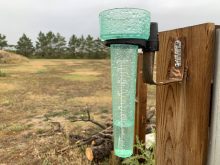Cellular communication systems are creating opportunities for automated machinery guidance.
That gives producers free time in the cab, which presents an opportunity to reach outside the cab to do business.
As prairie demand grows for affordable and reliable sub-inch RTK GPS, two of the biggest players turned to cellphone technology to fine tune their signals and bring prices below $3,000.
Raven and Trimble have introduced agriculture-oriented RTK GPS that eliminates the need for differential correction towers at the edges of fields.
Until now, conventional RTK was line-of-sight between the differential correction tower and the implement. Trees, hills, buildings and other obstructions interrupted the signal, causing false guidance information.
Read Also

Manitoba bans wild boar possession
Manitoba has tightened the regulatory status of Eurasian wild boar in an effort to help fight back against invasive wild pigs.
The new systems from Raven and Trimble do not depend on line-of-sight. Both depend on existing cellphone systems.
Raven recently bought the Alberta-based Ranchview system and re-named it Slingshot. This unique system sends corrected positioning signals to a pair of special high gain rover antenna on the implement cab via the existing cellular network.
The Ranchview system depends on existing technologies and manages them with special software, according to Clint Mundt, Ranchview president and the engineer who made it work.
“The correction signals are transmitted to you through the digital cellular network,” says Mundt.
“If there’s cellular service at your field, we can give you survey grade RTK and the accuracy is repeatable every year.
“The new modem you buy doesn’t replace your existing GPS. Rather, it plugs into that system to give it highly accurate and reliable correction signals,” says Mundt, who was recently hired by Raven to serve as chief engineer on the Slingshot project.
The new signal starts at the local Slingshot dealer, which can be a grain elevator, fertilizer outlet, crop adviser, implement dealership or any other agriculture service provider.
The system has no need for tall towers or grain elevators because it never uses direct line-of-sight.
Instead, a stationary Slingshot GPS antenna is affixed to a dealer’s roof. The receiver is similar to those on implement cab roofs. Like any GPS receiver, all it needs is an unobstructed view of the sky.
The Slingshot base station inside the dealership plugs into the dealer’s existing high-speed internet. GPS signals from the roof-mounted receiver go to the Slingshot base station inside the building, where corrections are generated, based on the precise location of the receiver on the roof.
From there, correction data is sent to the Slingshot servers via the dealer’s internet.
After additional adjustments by Ranchview software, the server feeds corrected signals to the customer through the cellphone network. A customer can obtain accurate guidance data as long as they are within 80 kilometres of a dealer’s rooftop receiver.
At the implement, the customer installs a Raven modem called the field hub. Mundt says the twin, high-gain antennas on the roof are key to receiving and processing accurate data on the implement. These antennas receive correct data even when cellphone signals fade out.
In tests conducted in 2009, Ranchview had good accuracy as far as 130 km from the dealer’s roof when running the signal through the latest high quality GPS systems.
The field hub costs $2,000. The annual subscription fee is $1,500. The customer is also responsible for additional costs incurred through the data plan with the wireless phone provider. This can be as high as $100 per month depending on the plan and how much it’s used.
Trimble took a different approach to piggybacking on cellphone technology, by plugging an Ag3000 GSM/GPRS cellular modem directly into the implement’s guidance system. The new modem has a jack for an external antenna in areas where cellphone coverage may be weak.
Trimble calls its system Virtual Reference Station, or VRS.
Like the Raven, it eliminates dependence on line-of-sight by obtaining and transmitting corrections through high speed internet via cellphone systems.
VRS calculates corrections through a co-ordinated network of six stationary base stations evenly spread out over the dealer’s service area, usually about 70 km apart and fixed to rooftops.
In Alberta, where VRS is delivered through CanNet, base stations can be located as far as 100 km apart with no degradation of signal, according to CanNet’s David Jansens.
GPS positioning data received at these stationary stations is sent to a central server via the internet, where corrections are made. By co-ordinating the bases through this server, VRS improves accuracy within the network, regardless of the implement’s distance from any individual base station.
Trimble says a customer’s implement can operate anywhere within the dealer’s service area and get the same high level of accuracy.
VRS is different from continually operating reference stations (CORS), which use individual base stations that are not co-ordinated through a central server.
According to Trimble, CORS encounters signal degradation similar to conventional RTK systems using radio signals.
In the Trimble system, the moving implement picks up the normal GPS signal from American military satellites with the regular rover antenna on the cab roof.
The correction data arrives at the moving implement from the VRS central server through the internet carried by the cellular provider. CanNet serves Alberta with considerable coverage. SaskTel serves Saskatchewan and MTS serves Manitoba with weaker networks than Alberta’s.
“Saskatchewan has pretty poor cellphone coverage in most areas,” says Vern Anderson, GPS specialist with Redhead Equipment.
“But you have to realize that data through a cellphone will usually transfer where cellular voice communications will not transfer. Your cellphone may be out of reach for talking, but the signal for sending data to the modem in your tractor is still strong enough. Usually. But not always.”
The Trimble VRS modem is priced between $2,000 and $3,000 depending on options. The annual subscription fee is $1,500 for each implement equipped with a modem.
As with other cellular systems, the monthly charge for the data plan depends on the cellular provider and extent of use.
Farmers who use laptops on-line from their cabs will have higher fees.
“I pay $70 a month to SaskTel. If you can keep your fingers off the keyboard, you can probably get by with $40 a month,” says Anderson.
He adds that conventional RTK might be the best solution in areas with bad cellular coverage or for farmers who want to equip more than one or two implements with rovers.
“Or, if you have a compact land base spread out over just 10 or 12 miles and you already have a tall structure of some kind, regular RTK might be the best solution.”
Anderson says each rover-equipped implement on a cellular system is charged the same annual subscription fee. A half dozen units totals $9,000 a year.
“For $13,000 you can buy a Trimble base station that gives you correction signals either on high-speed internet or on radio. Then you own the system and there’s no annual subscription fees.”















